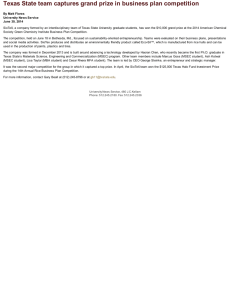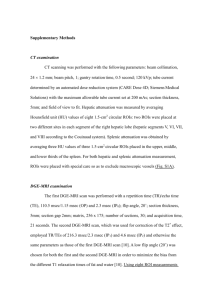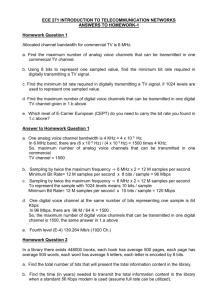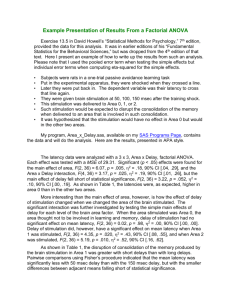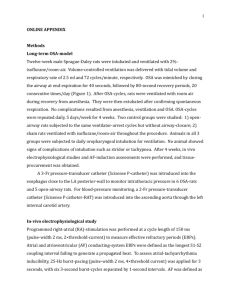kapela-umich-edited
advertisement
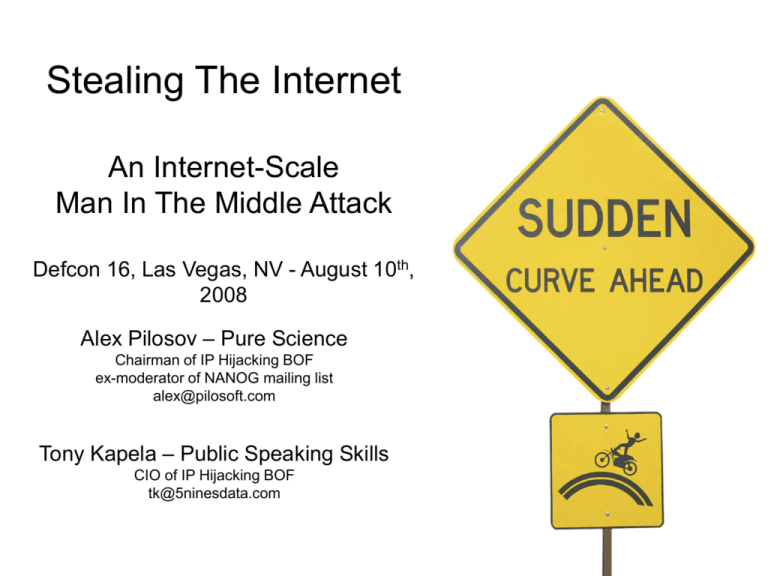
Stealing The Internet An Internet-Scale Man In The Middle Attack Defcon 16, Las Vegas, NV - August 10th, 2008 Alex Pilosov – Pure Science Chairman of IP Hijacking BOF ex-moderator of NANOG mailing list alex@pilosoft.com Tony Kapela – Public Speaking Skills CIO of IP Hijacking BOF tk@5ninesdata.com Why Should You Care? • Because your inbound traffic can be passively intercepted • Because your outbound traffic to specific destinations can also be intercepted • Because your data can be stored, dropped, filtered, mutilated, spindled, or modified • Because this cannot be solved without provider cooperation • Because it’s unlikely to be noticed, unless you’re looking for it Agenda • BGP & Internet 101 • Old Hijackings • The main monkey business – MITM method, explained – Graphs, etc – Live Demo BGP 101 How is the Internet ‘glued’ together? • No central “core” • Individual networks (identified by ASN) interconnect and “announce” IP space to each other • Announcement contains IP prefix, AS-PATH, communities, other attributes • AS-PATH is a list of who has passed the announcement along; used to avoid loops (important for our method) • Fundamental tenet in IP routing: More-specific prefixes will win – e.g. 10.0.0.0/24 wins over 10.0.0.0/8 ..if we had to whiteboard it graphic courtesy jungar.net Network Relationship Norms • Peer: No money changes hands, routes are not redistributed to transits and other peers – 1:1 relationship • Customer: Pays transit provider to accept their announcement, sends routes to peers and transits On Prefixes… • Internet routing is inherently trust-based – No “chain of trust” in IP assignments • ICANN assigns space to Regional Internet Registries (RIRs - ARIN/RIPE/AFRINIC) • RIRs assign to ISPs or LIRs (in RIPE region) • No association between ASN and IP for most assignments (except RIPE) State The problem Various levels of sophistication in Route/Prefix Filtering • Customer: – Often unfiltered BGP: max-prefix and sometimes ASPATH – Smaller carriers and smaller customers – static prefix-list, emails or phone calls to update • Verification by “whois” – Larger carriers: IRR-sourced inter-AS filters • Peer: – Typically none beyond max-prefix and scripts to complain when announcing something they shouldn’t (rare) – Many don’t even filter their own internal network routes coming from external peers The IRR (Internet Routing Registry) A Modest Proposal • Way for ISP’s to register their routes and routing policy • Distributed servers that mirror each other • Filtering based on IRR will prevent some ‘accidental’ hijackings • Caveats – Your routers might not scale as well when crunching 100k entry prefix-lists per-peer, for all peers – Full of cruft - no janitors – Insecure - anyone can register (nearly) any route An IRR Update …Which Should Have Been Questioned From: db-admin@altdb.net To: xxx@wyltk-llc.com ReplyTo: db-admin@altdb.net Subject: Forwarded mail.... (fwd) Sent: Aug 7, 2008 9:48 PM Your transaction has been processed by the IRRd routing registry system. Diagnostic output: ----------------------------------------------------------The submission contained the following mail headers: - From: xxx@wyltk-llc.com Subject: Forwarded mail.... (fwd) Date: Thu, 7 Aug 2008 21:48:53 -0400 (EDT) Msg-Id: <Pine.LNX.xxx@wyltk-llc.com> ADD OK: [route] 24.120.56.0/24 AS26627 ---------------------------------------If you have any questions about ALTDB, please send mail to db-admin@altdb.net. Traditional Hijacking Uses • Non-Malicious use: was popular in 2001, faster than getting IPs legitimately from ARIN • Fly-by spammers: Announce space, spam, withdraw, avoid abuse complaints • Malicious DoS or outage - silence your competitors • Target impersonation - could hijack 128.121.146.0/24 (twitter) and put up something else Criminality • If nobody is using it, is it really illegal? • IP prefix is just a number • No prosecutions for non-malicious announcements that we are aware of • Worst case scenario for non-malicious hijack: ARIN/RIPE pull PTR records and transits shut you off (eventually) How-To Hijack • Full hijacking, apparent authority to announce – This was cool in 2001 – Find IP Network (using whois) with contact email address in @hotmail.com or at domain that has expired – Register domain/email – Change contact • Or just announce the network since nobody is filtering anyway – Upstream providers too busy & big to care – You’re paying them to accept routes, so they do Historical Hijackings • AS7007 – ’97, accidental bgp->rip->bgp redistribution broke Internet (tens of thousands of new announcements filled router memory, etc) • 146.20/16 – Erie Forge and Steel (how apropos) • 166.188/16 – Carabineros De Chile (Chile Police) – hijacked twice, by registered “Carabineros De Chile LLC, Nevada Corporation” • More details available on completewhois.com • Accidental hijackings happen frequently – low chance of getting caught 02/08 Youtube Hijack Saga • YouTube announces 5 prefixes: – A /19, /20, /22, and two /24s – The /22 is 208.65.152.0/22 • Pakistan’s government decides to block YouTube • Pakistan Telecom internally nails up a more specific route (208.65.153.0/24) out of YouTube’s /22 to null0 (the routers discard interface) • Somehow redists from static bgp, then to PCCW • Upstream provider sends routes to everyone else… • Most of the net now goes to Pakistan for YouTube, gets nothing! • YouTube responds by announcing both the /24 and two more specific /25s, with partial success • PCCW turns off Pakistan Telecom peering two hours later • 3 to 5 minutes afterward, global bgp table is clean again Pakistan Govt. Notice Of Interest… IP Hijacking BoF • Un-official event at NANOG conference • We test security of Internet routing infrastructure • Recent exercises: – Hijacked 1.0.0.0/8: 90% success – Hijacked 146.20.0.0/16: 95% success – Attempted to announce networks longer than /24: from /25 down to /32 with cooperation of large CDN’s. 40% successful overall Routing Security Is Complicated • No answer yet, due to lack of chain of trust from ICANN on down • “Weakest link” problem: Until everyone filters everyone perfectly, this door is still open • Best practice today is “Alerting” systems that look for rogue announcements (PHAS, RIPE MyASN, Renesys, etc) • Register your AS and your prefix in RIR (no immediate effect, but eventually someone will use them) • No anonymity – if you hijack, everyone knows it’s you (due to AS-PATH) • If things still work, who complains? How To Resolve A Hijacking • Once rogue announcement is identified, work begins. Contact the upstreams and scream. – May take minutes, hours (if you are Youtube-sized), or possibly days • About as easy as getting DDoS stopped (or not) What This Means • Rootkits + 0day rogue announcements Man-in-middle attacks, with our clues applied – No need for three-way-handshake when you’re in-line – Nearly invisible exploitation potential, globally • Endpoint enumeration - direct discovery of who and what your network talks to • Can be accomplished globally, any-to-any • How would you know if this isn’t happening right now to your traffic at DEFCON? BGP MITM Hijack Concept • We originate the route like we always did – Win through usual means (prefix length, shorter aspath w/ several origin points, etc) • • We return the packets somehow – – • “Win” is some definition of “most of the internet chooses your route” Coordinating delivery was non-trivial Vpn/tunnel involve untenable coordination at target Then it clicked – use the Internet itself as reply path, but how? BGP MITM Setup 1. Traceroute & plan reply path to target 2. Note the ASN’s seen towards target from traceroute & bgp table on your router 3. Apply as-path prepends naming each of the ASN’s intended for reply path 4. Nail up static routes towards the nexthop of the first AS in reply path 5. Done BGP MITM – First Observe View of Forwarding ASN 200 originates Information Base (FIB) for 10.10.220.0/22, sends Internet is converged 10.10.220.0/22 after announcements to AS20 towards valid route converging and AS30 Random User ASN 100 AS10 AS40 AS60 AS20 AS30 Target ASN 200 AS50 BGP MITM – Plan reply path We then build ourshows as-path prepend ASN 100’s FIB route for list to include AS 10, and 200 10.10.200.0/22 via20, AS10 Attacker ASN 100 AS10 AS40 AS60 AS20 AS30 Target ASN 200 AS50 BGP MITM – Setup Routes 10.10.220.0/24 is announced with a route-map: Then, install static route in AS100 for 10.10.220.0/24 to permit AS10’s10 link route-map hijacked match ip address prefix-list jacked 4.3.2.1 ip route 10.10.220.0 255.255.255.0 set as-path prepend 10 20 200 Attacker ASN 100 AS10 AS40 AS60 AS20 AS30 Target ASN 200 AS50 Anonymzing The Hijacker • We adjust TTL of packets in transit • Effectively ‘hides’ the IP devices handling the hijacked inbound traffic (ttl additive) • Also hides the ‘outbound’ networks towards the target (ttl additive) • Result: presence of the hijacker isn’t revealed Without TTL adjustment 2 3 4 5 6 7 8 9 10 11 12 13 14 15 16 17 18 19 20 21 22 23 12.87.94.9 [AS 7018] 4 msec 4 msec 8 msec tbr1.cgcil.ip.att.net (12.122.99.38) [AS 7018] 4 msec 8 msec 4 msec ggr2.cgcil.ip.att.net (12.123.6.29) [AS 7018] 8 msec 4 msec 8 msec 192.205.35.42 [AS 7018] 4 msec 8 msec 4 msec cr2-loopback.chd.savvis.net (208.172.2.71) [AS 3561] 24 msec 16 msec 28 msec cr2-pos-0-0-5-0.NewYork.savvis.net (204.70.192.110) [AS 3561] 28 msec 28 msec 28 msec 204.70.196.70 [AS 3561] 28 msec 32 msec 32 msec 208.175.194.10 [AS 3561] 28 msec 32 msec 32 msec colo-69-31-40-107.pilosoft.com (69.31.40.107) [AS 26627] 32 msec 28 msec 28 msec tge2-3-103.ar1.nyc3.us.nlayer.net (69.31.95.97) [AS 4436] 32 msec 32 msec 32 msec * * * (missing from trace, 198.32.160.134 – exchange point) tge1-2.fr4.ord.llnw.net (69.28.171.193) [AS 22822] 32 msec 32 msec 40 msec ve6.fr3.ord.llnw.net (69.28.172.41) [AS 22822] 36 msec 32 msec 40 msec tge1-3.fr4.sjc.llnw.net (69.28.171.66) [AS 22822] 84 msec 84 msec 84 msec ve5.fr3.sjc.llnw.net (69.28.171.209) [AS 22822] 96 msec 96 msec 80 msec tge1-1.fr4.lax.llnw.net (69.28.171.117) [AS 22822] 88 msec 92 msec 92 msec tge2-4.fr3.las.llnw.net (69.28.172.85) [AS 22822] 96 msec 96 msec 100 msec switch.ge3-1.fr3.las.llnw.net (208.111.176.2) [AS 22822] 84 msec 88 msec 88 msec gig5-1.esw03.las.switchcommgroup.com (66.209.64.186) [AS 23005] 84 msec 88 msec 88 msec 66.209.64.85 [AS 23005] 88 msec 88 msec 88 msec gig0-2.esw07.las.switchcommgroup.com (66.209.64.178) [AS 23005] 88 msec 88 msec 88 msec acs-wireless.demarc.switchcommgroup.com (66.209.64.70) [AS 23005] 88 msec 84 msec 84 msec With TTL Adjustments 2 3 4 5 6 7 8 9 10 11 12 13 12.87.94.9 [AS 7018] 8 msec 8 msec 4 msec tbr1.cgcil.ip.att.net (12.122.99.38) [AS 7018] 4 msec 8 msec 8 msec ggr2.cgcil.ip.att.net (12.123.6.29) [AS 7018] 4 msec 8 msec 4 msec 192.205.35.42 [AS 7018] 8 msec 4 msec 8 msec cr2-loopback.chd.savvis.net (208.172.2.71) [AS 3561] 16 msec 12 msec * cr2-pos-0-0-5-0.NewYork.savvis.net (204.70.192.110) [AS 3561] 28 msec 32 msec 32 msec 204.70.196.70 [AS 3561] 28 msec 32 msec 32 msec 208.175.194.10 [AS 3561] 32 msec 32 msec 32 msec gig5-1.esw03.las.switchcommgroup.com (66.209.64.186) [AS 23005] 88 msec 88 msec 84 msec 66.209.64.85 [AS 23005] 88 msec 88 msec 88 msec gig0-2.esw07.las.switchcommgroup.com (66.209.64.178) [AS 23005] 84 msec 84 msec 88 msec acs-wireless.demarc.switchcommgroup.com (66.209.64.70) [AS 23005] 88 msec 88 msec 88 msec Compare Original BGP & Route Path Original: 2 3 4 5 6 7 8 9 10 11 12 13 14 12.87.94.9 [AS 7018] 8 msec 8 msec 4 msec tbr1.cgcil.ip.att.net (12.122.99.38) [AS 7018] 8 msec 8 msec 8 msec 12.122.99.17 [AS 7018] 8 msec 4 msec 8 msec 12.86.156.10 [AS 7018] 12 msec 8 msec 4 msec tge1-3.fr4.sjc.llnw.net (69.28.171.66) [AS 22822] 68 msec 56 msec 68 msec ve5.fr3.sjc.llnw.net (69.28.171.209) [AS 22822] 56 msec 68 msec 56 msec tge1-1.fr4.lax.llnw.net (69.28.171.117) [AS 22822] 64 msec 64 msec 72 msec tge2-4.fr3.las.llnw.net (69.28.172.85) [AS 22822] 68 msec 72 msec 72 msec switch.ge3-1.fr3.las.llnw.net (208.111.176.2) [AS 22822] 60 msec 60 msec 60 msec gig5-1.esw03.las.switchcommgroup.com (66.209.64.186) [AS 23005] 60 msec 60 msec 60 msec 66.209.64.85 [AS 23005] 64 msec 60 msec 60 msec gig0-2.esw07.las.switchcommgroup.com (66.209.64.178) [AS 23005] 60 msec 64 msec 60 msec acs-wireless.demarc.switchcommgroup.com (66.209.64.70) [AS 23005] 60 msec 60 msec 60 msec Hijacked: 2 3 4 5 6 7 8 9 10 11 12 13 12.87.94.9 [AS 7018] 8 msec 8 msec 4 msec tbr1.cgcil.ip.att.net (12.122.99.38) [AS 7018] 4 msec 8 msec 8 msec ggr2.cgcil.ip.att.net (12.123.6.29) [AS 7018] 4 msec 8 msec 4 msec 192.205.35.42 [AS 7018] 8 msec 4 msec 8 msec cr2-loopback.chd.savvis.net (208.172.2.71) [AS 3561] 16 msec 12 msec * cr2-pos-0-0-5-0.NewYork.savvis.net (204.70.192.110) [AS 3561] 28 msec 32 msec 32 msec 204.70.196.70 [AS 3561] 28 msec 32 msec 32 msec 208.175.194.10 [AS 3561] 32 msec 32 msec 32 msec gig5-1.esw03.las.switchcommgroup.com (66.209.64.186) [AS 23005] 88 msec 88 msec 84 msec 66.209.64.85 [AS 23005] 88 msec 88 msec 88 msec gig0-2.esw07.las.switchcommgroup.com (66.209.64.178) [AS 23005] 84 msec 84 msec 88 msec acs-wireless.demarc.switchcommgroup.com (66.209.64.70) [AS 23005] 88 msec 88 msec 88 msec In conclusion • We learned that any arbitrary prefix can be hijacked, without breaking end-to-end • We saw it can happen nearly invisibly • We noted the BGP as-path does reveal the attacker • Shields up; filter your customers. Thanks & Praise • • • • • Felix "FX" Lindner Jay Beale Dan Kaminsky Defcon Speaker Goons & Staff Todd Underwood
